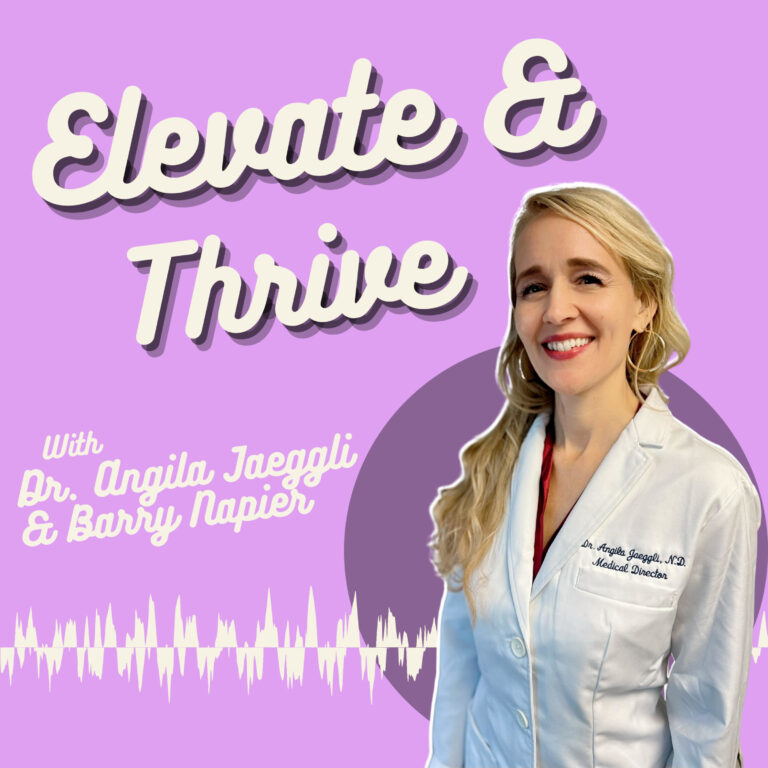
Welcome to the Body Mind Business podcast—the ultimate hub for those hungry to optimize their life, and those ready for a radically better path forward.
Barry and Angila blend powerful optimism, raw honesty, compassionate science, and actionable insights to help you achieve your goals, fix your health, and unlock peak performance.
Your next-level journey starts here.
”This feels like freedom…freedom from the constant chatter and noise in my mind about food. It's just quiet now.” — A patient's revelation that captures what these medications actually deliver.
In this no-bullshit episode of Optimize & Thrive, Barry and Dr. Angila expose the uncensored truth about GLP-1 medications (Semaglutide, Tirzepatide, Retatrutide) that are revolutionizing our relationship with food.
This isn't about magic pills. This is about LIBERATION from the mental prison most don't realize they're trapped in:
- The voice that won't shut up about those another sweet, a few more chips, or just one more glass of wine
- The shame spiral after ”failing” on diet #47
- The frustration when food calls to you with a power you can't fight
Barry transformed from extreme diet zealot to finding something that actually works. What happened next will make you question everything you thought you knew about cravings and why diets keep failing you.
”I would put these up there with penicillin. That's how important I think these are.” – your beloved host's extreme statement.
But hat's not hyperbole…
That's Barry after experiencing what happens when your biochemistry stops fighting against you.
Dr. Angila reveals what's happening beneath the surface that the ”eat less, move more” crowd doesn't want you to know:
- What if your body could finally tap into fat stores without suffering?
- What if the entire weight loss industry has been selling you a lie?
- High achievers who've mastered everything except their food relationship
- Chronic dieters trapped in the soul-crushing lose-gain-repeat cycle
- Anyone whose potential is hijacked by constant food thoughts
- Why the newest generation medications make early versions look primitive
- The shocking truth about muscle loss Instagram ”experts” keep getting wrong
- The approach that transformed Barry from skeptic to believer
- The 1% edge for driven professionals to get in the best shape of their life, faster, with less hardship than ever before
- And most importantly, the biggest myths and mistakes about taking a GLP-1 shot with exactly what you need to do instead
Consider this… when the food noise finally stops, who will you become?
Listen to find out.

Hey there, lovely readers!
Have you ever been in the middle of your morning routine, running a brush through your hair, only to find more strands tangled in the bristles than you’d like? If you’ve been noticing an unsettling increase in hair fall or thinning patches, first off—breathe. You’re not alone in this, and science has some fascinating insights (and solutions) to offer.
Why Does Hair Loss Happen Anyway?
Hair loss isn’t a one-size-fits-all situation. Both men and women can experience it, and the causes range from genetics to hormones, stress to certain medications, and even our diet. Surprising, right? Here’s a quick breakdown:
- Genetics: Ever heard of male-pattern or female-pattern baldness? Yep, it’s a family thing. If your parents or grandparents had hair loss, there’s a chance you might experience it too.
- Hormonal Changes: Pregnancy, childbirth, menopause, and thyroid issues can all cause hair loss.
- Medications: Some medicines for arthritis, cancer, heart problems, and even high blood pressure can result in hair thinning.
- Stress: Severe stress can cause sudden hair loss which could last several months.
- Diet: Not getting enough iron or protein? It might be showing in your hair.
Unpacking Hair Restoration
Now, let’s get into the exciting part: Hair Restoration! 🌱
The world of hair restoration has advanced leaps and bounds in recent years. It’s no longer just about transplants. Let’s explore two of the top methods:
- Topical Treatments: These are medicines you apply directly to the scalp. Minoxidil (you might know it as Rogaine) is one such popular treatment. It works by prolonging the growth phase of hair—meaning, it can delay hair from falling out too soon.
- PRP: Before we wrap up, there’s one more cutting-edge treatment in the world of hair restoration that deserves special mention: Platelet-Rich Plasma (PRP) Therapy.
- So, What’s PRP All About?
- Your blood is a fascinating concoction. Among other components, it contains plasma, and within that plasma are platelets. These platelets are rich in growth factors—molecules that play a pivotal role in healing.
- PRP therapy involves drawing a small amount of your blood, processing it to concentrate the platelets, and then injecting this concentrated PRP into your scalp. Sounds futuristic, doesn’t it?
- The Benefits of PRP for Hair Restoration
- Natural & Safe: Since PRP uses your blood, there’s little risk of allergic reactions or infections. It’s as natural as it gets!
- Stimulates Hair Growth: Those growth factors in PRP? They’re believed to stimulate dormant hair follicles and encourage them to enter the growth phase.
- Improves Hair Health: Many people report increased hair growth and healthier, thicker strands after undergoing PRP treatments.
- And the best part? PRP therapy is minimally invasive and requires little to no downtime. Plus, it pairs wonderfully with other treatments, offering a holistic approach to hair restoration.
- Taking the Next Step with PRP
- If PRP sounds like something you’d want to explore, you’re in luck. At Sage, we offer PRP hair restoration treatments tailored to individual needs. With trained professionals and a patient-centric approach, we’re committed to helping you reclaim not just your hair, but your confidence too.
- So, What’s PRP All About?
Lifestyle Considerations That Impact Your Hair
Okay, let’s chat lifestyle. The health of your hair isn’t just about what products you put on it. Here’s how you can give your locks some extra love:
- Dietary Choices: Your hair craves nutrients like iron, protein, and vitamins. Foods like spinach, eggs, and berries can be beneficial. And, don’t forget to hydrate! Water isn’t just great for your skin.
- Avoid Tight Hairstyles: Tight buns or ponytails can cause tension on your hair and pull them from the roots. Let your hair down—literally!
- Limit Heat Styling: We all love a good blowout, but frequent heat styling can weaken hair proteins, leading to breakage.
Time to Take Action!
Reading all this might have you wondering about your own hair health. Is what you’re experiencing normal? Should you be doing something differently?
Here’s a tip: If you’re concerned about your hair, it’s always a good idea to chat with a professional. They can offer guidance tailored just for you, from recommending specific treatments to suggesting lifestyle changes.
And guess what? At Sage, we’re here to help. Whether you want to explore restoration treatments or just chat about that sudden hair thinning after your last beach vacation—we’ve got you.
Remember: Every strand of your hair tells a story, from genetics to lifestyle choices. With the right information and care, you can ensure it’s a story of strength, health, and beauty.
Ready to embark on your hair rejuvenation journey? Feel that hair confidence again. Reach out to us at Sage and let’s chat. You deserve a crown of hair you can be proud of! 🌟👑
Did you find this post enlightening? Spread the word and share the science of hair with friends and family!
